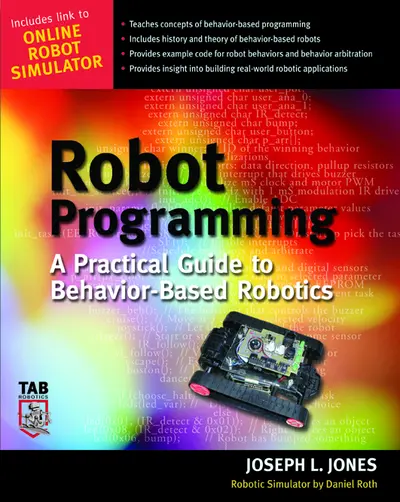My Account Details

ISBN10: 0071427783 | ISBN13: 9780071427784

Step 1 . Download Adobe Digital Editions to your PC or Mac desktop/laptop.
Step 2. Register and authorize your Adobe ID (optional). To access your eBook on multiple devices, first create an Adobe ID at account.adobe.com. Then, open Adobe Digital Editions, go to the Help menu, and select "Authorize Computer" to link your Adobe ID.
Step 3. Open Your eBook. Use Adobe Digital Editions to open the file. If the eBook doesn’t open, contact customer service for assistance.
Publisher's Note: Products purchased from Third Party sellers are not guaranteed by the publisher for quality, authenticity, or access to any online entitlements included with the product. MASTER ROBOT PROGRAMMING ITH YOUR OWN FREE VIRTUAL 'BOT! This ingenious book/Web site partnership teaches the skills you need to program a robot -- and gives you a virtual robot waiting online to perform your commands and test your programming expertise. You don't need to know either robotics or programming to get started! Using an intuitive method, Robot Programming deconstructs robot control into simple and distinct behaviors that are easy to program and debug for inexpensive microcontrollers with little memory. Once you’ve mastered programming your online 'bot, you can easily adapt your programs for use in physical robots. Though Robot Programming smoothes the path to acquiring skills in this arcane art, it does not reduce it to simplistics. With this resource, you can open the door to all the complexity, sophistication, versatility, and robustness that it is possible for robot behavior to exhibit. WHAT DO YOU WANT YOUR ROBOT TO DO? Robot Programming's hands-on approach to behavior-based robotics-- * Teaches you intuitively, with a system that integrates explanation, code examples, and exercises using an online robot simulator * Demonstrates programming for mobile robots * Gives you the tools to combine sensors with robot skills * Shows you how to develop new robot behaviors by manipulating old ones and adjusting programming parameters * Provides examples of programming for object seeking, object avoidance, decision-making, and much more * Leads you to advanced strategies for designing your own behavior-based systems from scratch * Introduces the history and theory behind behavior-based programming * Requires no background in either programming or robotics
PrefaceIntroductionAcknowledgmentsChapter 1: Autonomous Mobile RobotsChapter 2: Control SystemsChapter 3: BehaviorsChapter 4: ArbitrationChapter 5: ProgrammingChapter 6: DecompositionChapter 7: Physical InterfacesChapter 8: ImplementationChapter 9: Future RobotsAPPENDIX A: MATHEMATICS OF DIFFERENTIAL DRIVEAPPENDIX B: BSimAPPENDIX C: FREQUENTLY USED FUNCTIONSAPPENDIX D: PSEUDOCODEAPPENDIX E: BIBLIOGRAPHYINDEX
AcknowledgmentsChapter 1: Autonomous Mobile RobotsChapter 2: Control SystemsChapter 3: BehaviorsChapter 4: ArbitrationChapter 5: ProgrammingChapter 6: DecompositionChapter 7: Physical InterfacesChapter 8: ImplementationChapter 9: Future RobotsAPPENDIX A: MATHEMATICS OF DIFFERENTIAL DRIVEAPPENDIX B: BSimAPPENDIX C: FREQUENTLY USED FUNCTIONSAPPENDIX D: PSEUDOCODEAPPENDIX E: BIBLIOGRAPHYINDEX
Chapter 2: Control SystemsChapter 3: BehaviorsChapter 4: ArbitrationChapter 5: ProgrammingChapter 6: DecompositionChapter 7: Physical InterfacesChapter 8: ImplementationChapter 9: Future RobotsAPPENDIX A: MATHEMATICS OF DIFFERENTIAL DRIVEAPPENDIX B: BSimAPPENDIX C: FREQUENTLY USED FUNCTIONSAPPENDIX D: PSEUDOCODEAPPENDIX E: BIBLIOGRAPHYINDEX
Chapter 4: ArbitrationChapter 5: ProgrammingChapter 6: DecompositionChapter 7: Physical InterfacesChapter 8: ImplementationChapter 9: Future RobotsAPPENDIX A: MATHEMATICS OF DIFFERENTIAL DRIVEAPPENDIX B: BSimAPPENDIX C: FREQUENTLY USED FUNCTIONSAPPENDIX D: PSEUDOCODEAPPENDIX E: BIBLIOGRAPHYINDEX
Chapter 6: DecompositionChapter 7: Physical InterfacesChapter 8: ImplementationChapter 9: Future RobotsAPPENDIX A: MATHEMATICS OF DIFFERENTIAL DRIVEAPPENDIX B: BSimAPPENDIX C: FREQUENTLY USED FUNCTIONSAPPENDIX D: PSEUDOCODEAPPENDIX E: BIBLIOGRAPHYINDEX
Chapter 8: ImplementationChapter 9: Future RobotsAPPENDIX A: MATHEMATICS OF DIFFERENTIAL DRIVEAPPENDIX B: BSimAPPENDIX C: FREQUENTLY USED FUNCTIONSAPPENDIX D: PSEUDOCODEAPPENDIX E: BIBLIOGRAPHYINDEX
APPENDIX A: MATHEMATICS OF DIFFERENTIAL DRIVEAPPENDIX B: BSimAPPENDIX C: FREQUENTLY USED FUNCTIONSAPPENDIX D: PSEUDOCODEAPPENDIX E: BIBLIOGRAPHYINDEX
APPENDIX C: FREQUENTLY USED FUNCTIONSAPPENDIX D: PSEUDOCODEAPPENDIX E: BIBLIOGRAPHYINDEX
APPENDIX E: BIBLIOGRAPHYINDEX
Need support? We're here to help - Get real-world support and resources every step of the way.